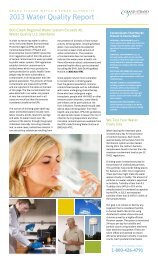Emergency Plan - Grand Strand Water and Sewer Authority
Emergency Plan - Grand Strand Water and Sewer Authority
Emergency Plan - Grand Strand Water and Sewer Authority
Create successful ePaper yourself
Turn your PDF publications into a flip-book with our unique Google optimized e-Paper software.
EVENT SPECIFIC GUIDELINES 14(ESG-14)<br />
HAZARDOUS MATERIAL RELEASE<br />
3.3. Hazardous Material Release<br />
3.3.1. SITUATION<br />
GSWSA utilizes a wide variety of chemicals <strong>and</strong> materials that, if released or used incorrectly,<br />
could create physical <strong>and</strong>/or health hazards. While any of these products are capable of<br />
causing problems under the right conditions (propane, gasoline, etc.), the primary chemicals of<br />
concern are chlorine <strong>and</strong> anhydrous ammonia.<br />
Both Wastewater Treatment <strong>Plan</strong>ts utilize chlorine in One-Ton cylinders. When full, these<br />
cylinders contain 2,000 pounds of liquid chlorine under pressure. A catastrophic, worst-case<br />
release could, according to air modeling, travel a maximum distance of up to 1.5 miles from<br />
the source of the release.<br />
The water treatment plant uses chlorine in one hundred <strong>and</strong> fifty pound cylinders. When full,<br />
these cylinders contain 150 pounds of liquid chlorine under pressure. A catastrophic, worstcase<br />
release could, according to air modeling, travel a maximum distance of up to 0.9 miles.<br />
The water treatment <strong>Plan</strong>t uses anhydrous ammonia in one hundred pound cylinders. When<br />
full, these cylinders contain 100 pounds of liquid anhydrous ammonia under pressure. A<br />
catastrophic, worst-case release could, according to air modeling, travel a maximum distance<br />
of up to 700 feet.<br />
All GSWSA chlorine <strong>and</strong> ammonia feed systems withdraw gas from the gas-space at the top of<br />
the cylinder, <strong>and</strong> this gas is introduced into a water stream to create a very strong chlorine or<br />
ammonia solution. This solution is then introduced into the treatment process at the desired<br />
locations<br />
3.3.2. THREAT or HAZARD INFORMATION<br />
CHLORINE<br />
Chlorine gas is one-<strong>and</strong>-one-half times heavier than air, so it tends to stay near the floor or<br />
ground, <strong>and</strong> settles into low-lying areas.<br />
Chlorine is highly aggressive in the presence of moisture, <strong>and</strong> will react with the moisture in<br />
your eyes, mouth, nose, lungs, <strong>and</strong> even on your skin.<br />
Even minor exposure to chlorine gas can irritate the lungs <strong>and</strong> respiratory system, <strong>and</strong> can lead<br />
to delayed complications.<br />
One volume of liquid chlorine (for example, one cubic foot) not under pressure <strong>and</strong> at normal<br />
room temperature, will rapidly vaporize (turn to gas) into 460 volumes of pure chlorine gas<br />
(for example, 460 cubic feet).<br />
Liquid chlorine is extremely cold, <strong>and</strong> will cause severe burns if it comes in contact with the<br />
skin.<br />
Chlorine is not flammable, but it is an oxidizer, so it does support combustion the same way<br />
oxygen does (makes things burn easier <strong>and</strong> better).<br />
<strong>Gr<strong>and</strong></strong> <strong>Str<strong>and</strong></strong> <strong>Water</strong> & <strong>Sewer</strong> <strong>Authority</strong> 129 CONFIDENTIAL MATERIALS<br />
<strong>Emergency</strong> Management <strong>Plan</strong><br />
SECURITY SENSITIVE<br />
June 7, 2013<br />
NOT FOR PUBLIC DISCLOSURE






